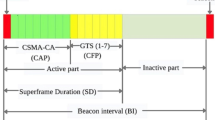Abstract
The wireless sensor networks (WSNs) based on the IEEE 802.15.4 beacon enabled mode provide a deterministic resource allocation offered by the guaranteed time slot (GTS) mechanism which is ideal for real-time traffic applications that requires high quality of service (QoS). In the beacon enabled mode the active and optional inactive period is governed by superframe order (SO) and beacon order (BO). Adapting the duty cycle using the SO and BO is desirable to accommodate the changing context of the WSNs traffic for network optimisation. However, existing approaches assumed a fixed SO and BO and segregate the evaluation of the contention access period and the contention free period that forms the active segment. To improve the performance of the IEEE 802.15.4 protocol in respect of the trade-off between power consumption and end-to-end delay, within a required QoS, a combination of dynamic priorities for traffic differentiation and dynamic duty cycle adaptation in the GTS allocation process are introduced. This work demonstrates that the proposed solution provides significantly better performance than the standard allocation method by simultaneously satisfying QoS and service differentiation demands with considerable power savings which is essential for WSNs. The specific novel use of this solution is in an application scenario where the deployed network is situated in an assisted living environment with a rich suite of heterogeneous wireless based communications in place.











Similar content being viewed by others
References
Ko, J., Lu, C., Srivastava, M. B., Stankovic, J. A., Terzis, A., & Welsh, M. (2010). Wireless sensor networks for healthcare. Proceedings of the IEEE, 98, 1947–1960.
Akyildiz, I. F., & Can Vuran, M. (2010). Wireless sensor networks: Advanced text in communications and networking. Hoboken: Wiley.
Sitharama Iyengar, S., Parameshwaran, N., Phoha, V. V., Balakrishnan, N., & Okoye, C. D. (2010). Fundamentals of sensor network programming: Applications and technology. Oxford: Wiley-IEEE Press.
Noda, C., Prabh, S., Alves, M., Boano, C., & Voight, T. (2011). Quantifying the channel quality for interference-aware wireless sensor networks 2011. In Proceedings of 10th international conference on information processing in sensor networks (IPSN) (pp. 167–168), ISBN 978-1-61284-854-9.
Koubaa, A., Alves, M., & Tovar, E. (2006). i-GAME: An implicit GTS allocation mechanism in IEEE 802.15.4 for time-sensitive wireless sensor networks. In 18th Euromicro conference on real-time systems (ECRTS ’06), Dresden (pp. 182–192).
Koubaa, A., Alves, M., Nefzi, B., & Song, Y.-Q. (2006). Improving the IEEE 802.15.4 slotted CSMA/CA MAC for time-critical events in wireless sensor networks. In 18th Euromicro conference on real-time systems (ECRTS ’06), Dresden.
Tennia, S., Koubaa, A., Daidone, R., Alves, M., Jurcik, P., Severino, R., Tiloca, M., Hauer, J., Pereira, N., Dini, G., Bouroche, M., & Tovar, E. IEEE 802.15.4 and zigbee as enabling technologies for low-power wireless systems with quality-of-service constraints, Springer Briefs in Electrical and Computer Engineering, Cooperating Objects, Springer, ISBN 978-3-642-37368-8.
Mishra, A., Na, C., & Rosenburgh, D. (2007, October). On scheduling guaranteed time slots for time sensitive transactions in the IEEE 802.15.4 Networks. In IEEE military communications conference (MILCOM ’07), Orlando, FL (pp. 1–7).
Villaverde, B. C., Rea, S., & Pesch, D. (2010, April). D-SeDGAM: A dynamic service differentiation based GTS allocation mechanism for IEEE 802.15.4 WSN. In 7th international conference on information technology: New generations (ITNG ’10), Las Vegas, NV (pp. 852–857).
Palafox, L. E., & Antonio, J. (2009). Garcia-Macias CICESE: Wireless sensor networks for voice capture in ubiquitous home environments, wireless pervasive computing 2009 IEEE Xplore. doi:10.1109/ISWPC.2009.4800614.
IEEE. (2006). IEEE 802.15.4 Ext Standard. Part 15.4: Wireless medium access control (MAC) and physical layer (PHY) specifications for low-rate wireless personal area networks (LR-WPANs). Piscataway, NJ: IEEE Press.
Allen, J. (2011). Development and evaluation of techniques for monitoring capacity and performance in wireless mesh networks. M.Sc., Software Engineering, Athlone Institute of Technology.
Na, C. W. (2011). IEEE 802.15.4 wireless sensor networks: GTS scheduling and service differentiation, PhD Thesis, Electrical and Computer Engineering, Virginia Polytechnic Institute and State University.
\(\text{ Crossbow }\_\text{ Technology }\). (2007, April). XMesh user’s manual. http://www.xbow.com/support/wUserManuals.aspx
Mangharam, R., Rowe, A., Rajkumar, R., & Suzuki, R. (2006). Voice over sensor networks, presented at the real-time systems symposium, Rio de Janeiro.
Lim, J.-H., & Jang, B. T. (2008). Dynamic duty cycle adaptation to real-time data in IEEE 802.15.4 based WSN. In 5th IEEE consumer communications and networking conference (CCNC ’08), Las Vegas, NV (pp. 353–357).
Stewart, R. (2002). End-to-end delay analysis for small/medium scale IP networks, Ph.D. Thesis, Queen Mary University of London.
Park, T. R., Kim, T. H., Choi, J. Y., Choi, S., & Kwon, W. H. (2005). Throughput and energy consumption analysis of IEEE 802.15.4 slotted CSMA/CA. IET Electronics Letters, 41, 1017– 1019.
Misic, J., Shafi, S., & Misic, V. B. (2005). The impact of MAC parameters on the performance of 802.15.4 PAN. Elsevier Ad Hoc Networks Journal, 3, 509–528.
OPNET official website. http://www.opnet.com.
Pratap Singh, C., Vyas, O. P., & Tiwari, M. K. (2008). A survey of simulation in sensor networks. In International conference on computational intelligence for modelling, control and automation, Vienna.
Huang, Y.-K., Pang, A.-C., & Hung, H.-N. (2008). An adaptive GTS allocation scheme for IEEE 802.15.4. IEEE Transaction in Parallel Distributed System, 19, 641–651.
Song, J., Ryoo, J.-D., Kim, S., Kim, J., Kim, H., & Mah, P. (2007, May). A dynamic GTS allocation algorithm in IEEE 802.15.4 for QoS guaranteed real-time applications. In IEEE international symposium on consumer electronics (ISCE ’07), Minneapolis, MN (pp. 1–6).
\(\text{ Research }\_\text{ Centre }\_\text{ in }\_\text{ Real-Time }\_\text{ Computing }\_\text{ Systems }\). CISTER. http://www.cister.isep.ipp.pt/.
Kleinrock, L., & Toubagi, F. A. (1975). Packet switching in radio channels: Part I—Carrier sense multiple access modes and their throughput-delay characteristics. IEEE Transactions on Communications, 23, 1400–1416.
Crossbow. (2004). MicaZ Datasheet - MPR2400CA. http://www.xbow.com/Products/Product_pdf_files/Wireless_pdf/MICAz_Datasheet.pdf.
Author information
Authors and Affiliations
Corresponding author
Rights and permissions
About this article
Cite this article
Hassan, M.N., Murphy, L. & Stewart, R. Traffic differentiation and dynamic duty cycle adaptation in IEEE 802.15.4 beacon enabled WSN for real-time applications. Telecommun Syst 62, 303–317 (2016). https://doi.org/10.1007/s11235-015-0074-x
Published:
Issue Date:
DOI: https://doi.org/10.1007/s11235-015-0074-x




